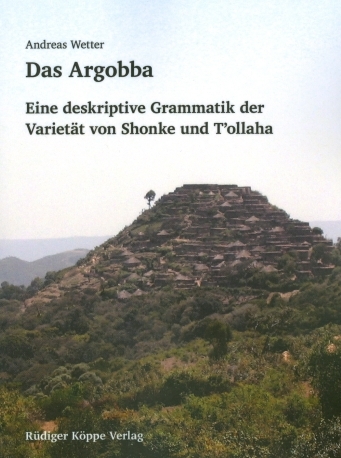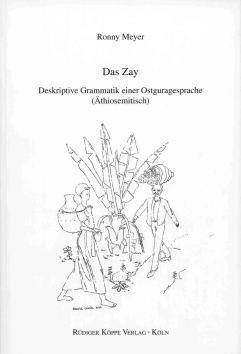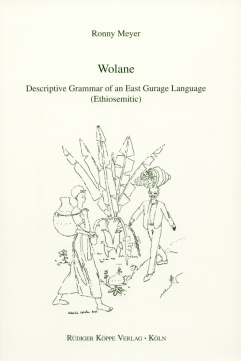




Argobba is an endangered language which belongs to the South-Ethiosemitic sub-branch of the Afroasiatic language phylum. It is spoken by the ethnic community of the Argobba in the areas of northeast Shewa and southeast Wollo in central Ethiopia. Due to the dominance of Amharic and Oromo, the number of Argobba speakers is continually decreasing: the most recent survey of 1994 resulted in a number of 10,900 speakers only. This means that in 1994 only about every sixth Argobba still spoke this language.
While, for a long time, it had been said to be a dialect of Amharic, today Argobba is classified as an independent language. There are several local varieties of which two are known. The one described here in detail is the variety spoken in the villages of Shonke and T’ollaha in the Ethiopian Wällo region. Especially remarkable for this variety is a set of archaic features which include, for example, pharyngeal consonants and a complex allocation of allomorphs of dependent object markers.
The contents of the present grammar are listed in the order of the structural levels of the language description.
The introduction summarizes the state of knowledge regarding the classificatory and sociolinguistic situation of Argobba, the state of research as well as the historic and socio-cultural key data of the Argobba ethnic community. The introductory chapter ends with a short description of the research this grammar is based on.
The actual description of the language starts with the presentation of its phonological system, followed by three chapters dealing with the verbal complex from a morphological perspective: A description of the non-linear template structure typical for Semitic languages; The TAM system and verbal derivation; The nominal complex including pronouns, adverbs, numerals and quantifiers as well as relational nouns, and the group of functional elements like ad-positions and particles. The subsequent chapter is dedicated to syntactical questions.
The present study ends with two appendices: The first contains two shorter exemplary texts with interlinearization, the second two different paradigms completing the paradigmatic forms which in the previous chapters are only partially described.
Under these links you will find publications by the author and descriptions of further Ethiosemitic languages and cultures:
In 2005 and 2006, there appeared in this series published by Rüdiger Köppe grammars of Wolane and Zay, two of the so-called Gurage languages, written by Ronny Meyer. In a review of these volumes (JSS 57/1), I wrote that it is ‘probably not an exaggeration ... to say that these [two volumes] offer the most complete descriptions of any modern Ethiopian language outside of Amharic’. Now in this same series comes this volume on a variety of Argobba, by Andreas Wetter, which makes an equally significant contribution to the field of Ethiopian Semitic. [...]
Wetter has also taken on that most important task of a linguist, namely, studying and describing a language whose future is bleak, and preserving that knowledge for future generations. As I implied at the beginning of this review, the last few years have seen great strides towards a better understanding of several Ethiopian Semitic languages. The same can be said for modern Semitic studies in general, where numerous grammars have appeared for Neo-Aramaic, Neo-Arabic, and Modern South Arabian languages. I hope that this trend continue, and that it leads both to more comparative studies of the Semitic languages, and to a greater appreciation of the Semitic family – with its very long and fascinating history – by the wider linguistic community.
Aaron Rubin in Journal of Semitic Studies, 58/2, 2013, 423-425
Die Grammatik ermöglicht dem Leser einen gründlichen Einblick in das Argobba und wird von nun an sicherlich das wichtigste Referenzwerk dieser Sprache sein. [...]
Besonders hervorzuheben sind seine gut verständlichen theoretischen Einführungen in einzelne Bereiche der Grammatik und seine sauberen Begriffsdefinitionen. Die komplexen Strukturen der Verbalmorphologie werden systematisch Schritt für Schritt erläutert. Auf diese Weise fällt es auch dem nicht semitistisch bzw. mit Amharischkenntnissen vorgebildeten Leser leicht, sich in die Sprachstruktur hineinzudenken. [...]
Wetters Interpretationen der grammatischen Strukturen sind durchweg innovativ und lösen sich von “verkrusteten” Begrifflichkeiten der klassischen Semitistik. Diesbezüglich zu erwähnen sind z.B. autosegmentale Ansätze, die moderne Analyse des Tempus-Aspekt-Systems oder die Verwendung des Begriffs “Applikativ”. [...]
Wetters größter [sic] Verdienst ist sicherlich die Schaffung eines bleibenden Dokuments der bedrohten Argobba-Sprache und damit hoffentlich eines Beitrags zu ihrer Erhaltung.
Michael Schulze in Aethiopica, 15/2012, 263-270
© 2026 by Rüdiger Köppe Verlag – www.koeppe.de